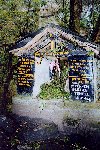...
 The roots of the Himalaya stretch far deeper and are far older than those of man,
but we still leave a noticable mark on the face of the landscape. There are the tracks and paths
created for trade, the terraces created for growing crops, the buildings erected to house both
people and animals. All this adds to the quality of life and the eye does not see it as a
mark upon, but rather as a part of, nature. More recently, and as a result of the toursit trade,
less aesthetic and less pleasing features are marring the landscape. Trekkers have a taste for
imported foodstuffs. The invariably plastic wrappers these food are packaged in can be seen
littering the landscape. Unlike glass bottles they are not transported out of the valley for
reuse. Unlike tin oil cans they can not be flattened out to panel a wall. Unlike paper they
cannot be burned and unlike waste food they will never rot.
The roots of the Himalaya stretch far deeper and are far older than those of man,
but we still leave a noticable mark on the face of the landscape. There are the tracks and paths
created for trade, the terraces created for growing crops, the buildings erected to house both
people and animals. All this adds to the quality of life and the eye does not see it as a
mark upon, but rather as a part of, nature. More recently, and as a result of the toursit trade,
less aesthetic and less pleasing features are marring the landscape. Trekkers have a taste for
imported foodstuffs. The invariably plastic wrappers these food are packaged in can be seen
littering the landscape. Unlike glass bottles they are not transported out of the valley for
reuse. Unlike tin oil cans they can not be flattened out to panel a wall. Unlike paper they
cannot be burned and unlike waste food they will never rot.
 More prolific than plastic wrappers are the plastic bottles used to carry mineral water. There is
no shortage of water in this area. There is in fact an excess as there is a constant flow from
streams and pipes in each village. The locals are accustomed to the germs commonly found in the water (those
too sensitive die young). The trekkers however are not and need access to clean drinking water.
Many authorities encourage trekkers to use iodine or chloring drops to treat the water. This is a cheap and
easy alternative to drinking bottled water and is all I did while I was there. It is true that cyclosporia
will not be killed by iodine, and that giardia requires a stronger dose than most people apply.
Boiling is always best, but I did not come across any cases of cyclosporia, and only one of giardia. Interestingly,
this was in an Australian in the town, not in the mountains. Nobody I met who was using iodine had any problems.
More prolific than plastic wrappers are the plastic bottles used to carry mineral water. There is
no shortage of water in this area. There is in fact an excess as there is a constant flow from
streams and pipes in each village. The locals are accustomed to the germs commonly found in the water (those
too sensitive die young). The trekkers however are not and need access to clean drinking water.
Many authorities encourage trekkers to use iodine or chloring drops to treat the water. This is a cheap and
easy alternative to drinking bottled water and is all I did while I was there. It is true that cyclosporia
will not be killed by iodine, and that giardia requires a stronger dose than most people apply.
Boiling is always best, but I did not come across any cases of cyclosporia, and only one of giardia. Interestingly,
this was in an Australian in the town, not in the mountains. Nobody I met who was using iodine had any problems.


|